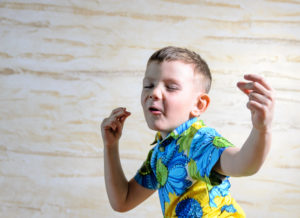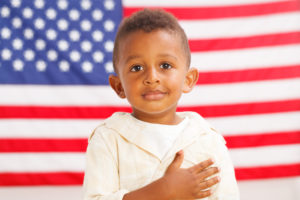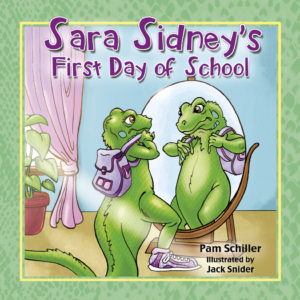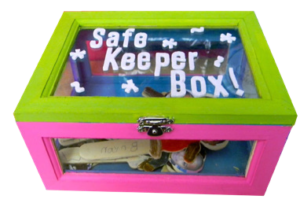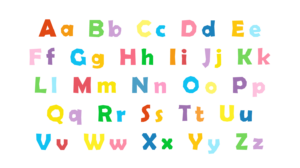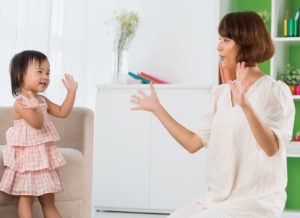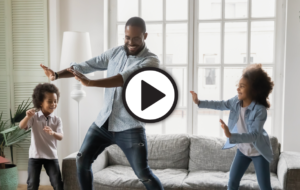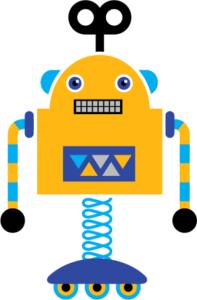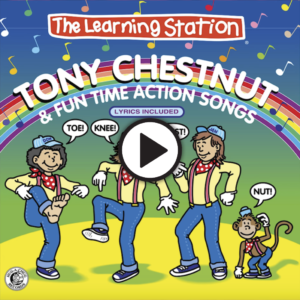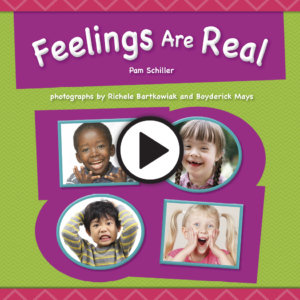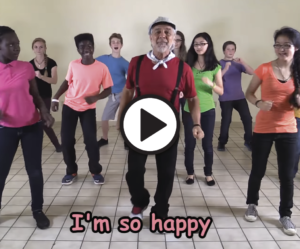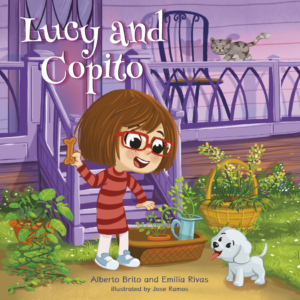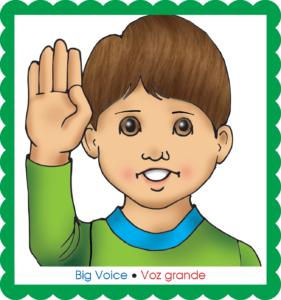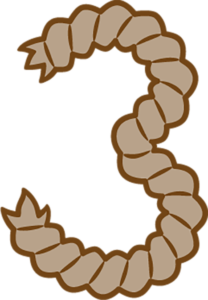My School and Me
Week 1: My School
This week, children will be introduced to their classroom whether that be at school or in their home learning environment. This is a great opportunity to create some routines that will help your child be a successful learner.
Word of the Week: routine
Before You Begin
Watch these videos to better understand the concepts your child will be learning this week. These are not videos you will watch with your child. These are just for you!
Supplies to Gather
- box
- coins and buttons
- glass
- glue
- ice cube tray
- journal
- markers and crayons
- paper
- paper clips
- pencils
- play dough
- rulers
- scissors
- small rocks
- snack items
- stick-on notes
- stuffed animal
The Alphabet
Sing the first verse of “The Alphabet Song.” Sing the song several times with your child. You can sing the song with or without the music. Explain: Alphabet letters are used to write names and other words. With your child, take a look around your home to find some alphabet letters.
A-B-C-D-E-F-G, H-I-J-K-L-M-N-O-P,
Q-R-S, T-U-V, W-X-Y and Z
Now I know my ABCs
Next time won’t you sing with me.
Vocabulary
Each week, you and your child will learn a special new word called the Word of the Week. This week’s word is routine. A routine is a set of activities that are repeated each day. Brushing teeth and washing hands are routines. With your child, think of some routines that each of you do daily. Use the word routine throughout the day. Click image to enlarge word.
Storytime
Watch the read-aloud video Chloe Gets Ready for School with your child. Explain that a teacher, Mrs. Ebel, will read a book to your child. The story is about a little girl who is getting ready for her first day of school.
Getting Ready
Prepare a home learning space. Ask: What supplies do you think we should put in your learning space? Look around for the supplies. Collect them and then find a container. Looking for a container that is the right size is an opportunity for learning. Some of the items you will want to have are paper, scissors, markers, crayons, pencils, ruler, glue, stick-on notes, paper clips, and play dough.

S.T.A.R.
Teach your child to take a deep belly breath in through the nose like sniffing a flower. Then flow the air out of the mouth as if blowing out a candle. Use the word S.T.A.R. to remember the steps: Smile, Take a deep breath, And Relax.

Alphabet Poster
On a large piece of paper or several smaller pieces, write the alphabet in ABC order. Show both the upper- and lowercase form of each letter. Put your alphabet poster on the wall in your learning space. Remind your child about “The Alphabet Song” and point to the letters as you sing it.
Storytime
Look at the cover Chloe Gets Ready for School. Show how to click on the arrow on the right side of the screen to turn pages in the book. Talk about how turning pages in an e-book and a physical book are different. Read the book.
Make a Plan
Invite your child to help you plan a sequence of learning activities during the day. Use words such as first, second, last, before, after to describe when these events will happen. Snap photos of the activities throughout the day. Then look at the photos and put them in order to show the sequence in which they happened.

Ask Questions
Scientists learn by asking questions and looking for answers. Have your child fill a glass with water. Ask: How do we use water? Where does it come from? How does the water look? How does it feel, smell, sound, and taste? Listen when your child suggests answers and say: We will be asking water questions this week to learn more.

Collect and Explore
Help your child gather coins and buttons to count, sort and explore. Ask: What can we do with the coins and buttons? Try out some of your child’s ideas. Ask: How are the coins and buttons alike or different? Talk about where to store each collection (bag or box) so you could use it again.

The Pledge
A pledge is a commitment or promise. At the beginning of a day at school, children stand, put their hands over their hearts and repeat a promise to be loyal to our country. Allegiance means loyalty. Say the “Pledge of Allegiance” for your child. Repeat it together. Click image for Pledge.
My Words in Print
Young learners need to know that what we say can be written down. Use a marker and paper to write down your child’s answer to this question: What is your favorite color? Then read the word as you point to it. Repeat with different questions.

Writing Together
Remind your child that Chloe was feeling sad to leave Bailey when she went to school. Ask: How do you think Bailey feels about Chloe going to school? Write Bailey feels __________ . Finish the sentence with your child’s idea. Read the sentence to your child, pointing to the words with your hand.

Listening Ears
One way to keep your home safe is to have agreements about how you want it to look, sound, and feel. Say: Today we will learn how to use Listening Ears. Listening Ears means paying attention when someone talks. Explain what this looks and sounds like. During the day, notice when your child is listening and point it out.
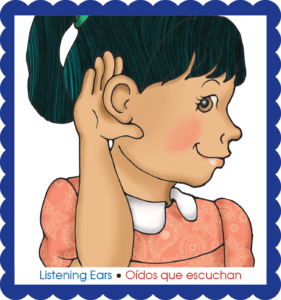
Storytime
Show Sara Sidney’s First Day of School. The main character is an iguana named Sara Sidney. Ask: Do you think this is a real story? Why? Confirm that this story is make-believe. Read the story. Say: All of the animals in Sara’s class are her classmates. Talk about how Sara’s classmates are alike and different.
Math at Snack Time
Practice math skills during snack time. For example, invite your child to sort, count and compare snack items (crackers, fruit slices, popcorn) by size, shape and color. Ask: How many carrots? Which slice is biggest? What shape is the end of each slice?

Freeze It! #1
Invite your child to fill an ice cube tray with water and help you place it inside the freezer. Help your child predict what will happen to the water. Ask: How does it feel inside the freezer? What will happen if we leave the water inside overnight? You will check on the water as part of a lesson tomorrow.

Collect Rocks
Help your child collect ten or more small rocks outside. Keep the rocks in a box or bag. Have your child look at and compare the rocks by shape, size and color. Ask: How are they alike or different? How do they feel?

At the Playground
Visit a neighborhood playground. As you walk back home, ask: What are your favorite places on the playground? Is there a spot where you hang upside down or slide like Sara Sidney did? What do you think it would be like if you never played outside?

Feeling Safe
Use a Safekeeper Ritual to begin your learning time. Say: My job is to keep our home safe. Your job is to help keep our home safe. If you are willing to help, put your commitment token in the Safekeeper Box. That is your promise to help keep our home safe. Click image to learn more about the Family Safekeeper Ritual.
My Journal
Create a personal journal for your child and yourself by folding several pages of paper in half and stapling the edge. (Or you could use a small readymade notebook.) Explain that you will both write and draw in the journals during learning time. Talk about what you each could draw on the cover of your journal. Use writing tools to draw pictures and write your names.
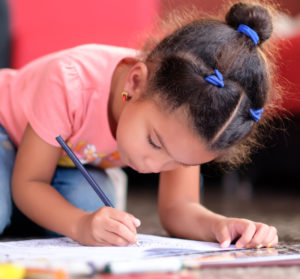
Sing and Clap
Listen to the first verse of “The Alphabet Song.” Have your child clap for each letter as you listen. Then try reciting the alphabet and clapping for the letters. Listen closely to see if your child is saying each individual letter and not running a series of letters together. Click image for lyrics.
Storytime
Watch the read-aloud video Chloe Gets Ready for School with your child. Ask: What did you learn about Chloe when you listened to Mrs. Ebel read the story this time? Focus on Chloe’s morning routine. Have your child retell what Chloe did using the words, first, next, then, and last. Compare your child’s morning routine to Chloe’s.
Count and Exercise
Set aside time each day for exercise. Count the exercises as you do them to practice math at the same time. For example, count together as you and your child do the same number of repetitions: ten jumping jacks, six sit-ups, passing a ball back and forth five times.

Freeze It! #2
Remove the ice cube tray you placed in the freezer on Day 3. Have your child look at and touch the ice. Ask: How did the water change? What made the water change to ice? What would happen if we did not put the ice back in the freezer? Leave the ice out overnight to continue the experiment on Day 5.

Name Puzzle
Print your child’s name on two note cards using markers or crayons. Make puzzle cuts between the letters on one card. Have your child put the puzzle together to spell her name. Suggest using the uncut notecard as a reference if needed.

My Name Is…
Use a stuffed animal to help your child learn the way to meet someone new. Have the animal say: My name is Herschel. What is your name? When your child answers, Herschel shakes hands and says: It is nice to meet you. Let your child become the voice of another stuffed animal and introduce himself to you.

Find the Letter
Give your child an alphabet block, plastic letter or card with a letter from his name written on it. Walk around your house together hunting for the letter. Ask: Where are some of the places in our home where we see (name alphabet letter)? Choose a different letter from your child’s name and play again.

Storytime
Ask your child to think about both of the stories you read this week (Chloe Gets Ready for School and Sara Sidney’s First Day of School). Ask: Which story might really happen? Which story is make-believe? Choose one or both of the books to reread today.
How Many Markers?
Have your child count the markers in your school supply box. Write down the number. Then have your child count again removing each marker lid. Write down this number. Count again while popping the lids back on the markers. Ask: Why was the count (number) the same each time?

Freeze It! #3
Have your child check the ice cube tray that was left outside the freezer overnight. Talk about what you see. Ask: Why did the ice melt? What does ice become when it melts? Review what your child has learned about water. (It turns to ice when it freezes. Ice melts when it is not in the freezer. Water can change from a liquid to a solid and back again.)

Clean-Up Math
Invite your child to help you gather things left lying around the house and place them inside a box or laundry bag. Help your child count how many items were collected. Discuss how to sort the items by where they belong: Which items belong in the closet, toy box, chest of drawers?

Favorite Colors
Chloe’s favorite color is yellow. Talk with your child about your favorite colors. Each of you should choose one favorite and gather several household items that are that color. You might even take a walk outside and gather some objects. Share your color collections with other family members.

My School and Me
Week 2: My Body
This week, you will learn that our awesome bodies come in different shapes, sizes, and colors. Every body part has a name. We can move our bodies in many ways!
Word of the Week: awesome
Before You Begin
Watch these videos to better understand the concepts your child will be learning this week. These are not videos you will watch with your child. These are just for you!
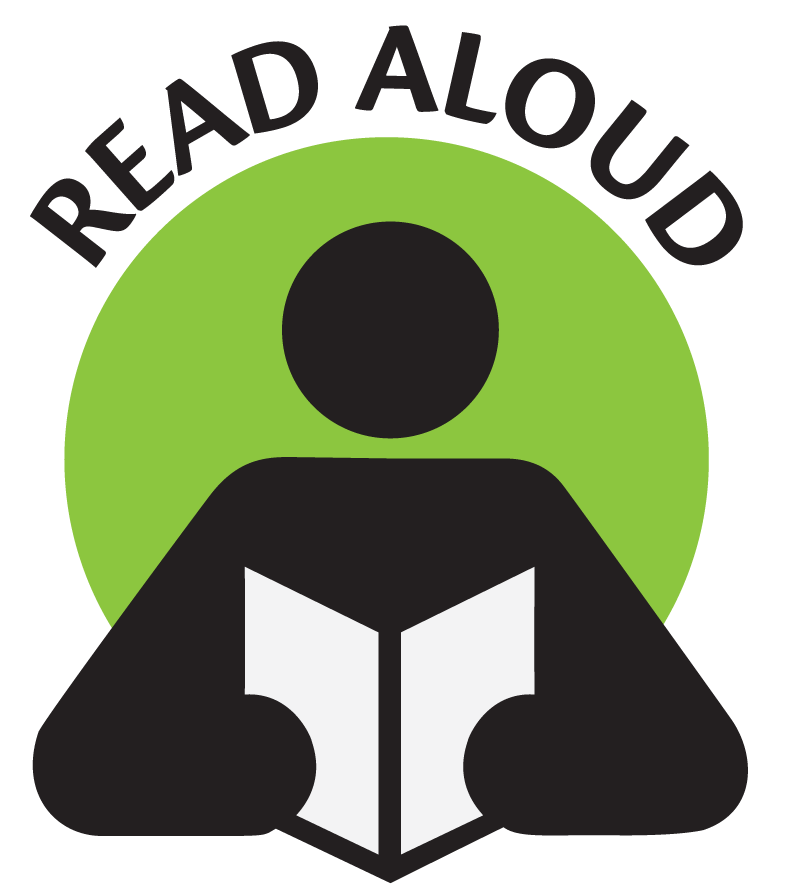
Books to Read
- Your Fabulous Skin eBook
- Your Fabulous Skin Read-Aloud video
Supplies to Gather
- beanbag or stuffed animal
- block
- coins
- construction paper
- drawing paper
- finger paint
- journal
- markers or crayons
- masking tape
- mirror
- paper plate
- plastic cups
- scissors
- small toy figures
- socks
- textured objects (sandpaper, sponge, ball)
- yarn
Connect with a Song
Singing and moving together helps you and your child come together or unite. Explain that this week you will learn about your bodies. Listen to and watch the music video “Head, Shoulders, Knees, and Toes.” Have your child point out the body parts named in the song. Sing along touching body parts as they are named.
Daily Message
Show me your ears.
- Say the sentence. Have your child repeat and then point to the body part named.
- Ask your child to recall the first word in the sentence. Write the word. Point to the word and have your child “read” the word with you.
- Repeat for each word. Track left to right (move your finger under the words) as you “read” the sentence together.
Body Bop
Enjoy dancing with your child. “Body Bop” is a great way for everyone in the family to move to music as your child learns the names of body parts and position words. Dance along with Don Monopoli’s music video.
Storytime
Watch the read-aloud video Your Fabulous Skin with your child. This book is nonfiction. It tells facts (things that are true) about your skin. Have your child listen for facts as Mr. Gonzales reads the book. Ask: Why does the author of the book say skin is fabulous? Do you agree? Why or why not?
Above and Below
Have your child bend at the waist to touch her toes. Fold a blank sheet of paper in half. Unfold the paper. Say: Pretend the fold is your waist. Point to your child’s waist. Have your child touch toes again as you refold the paper. Trace along the fold with a marker. Click image to show body parts for your child to identify as being above or below the waist.
Location Words
Gather several small toy figures or vehicles and several plastic cups. Direct your child to place the figures next to, between, in, and out of the cup. This will show an understanding of location words. If your child has difficulty, show the correct position and repeat the location word. For example, say: I put the truck next to the blue cup.

Trace Your Child
Have your child lie down on a large sheet of paper or flattened cardboard box. Trace around your child’s body with a marker. Help your child add details. Talk about the location of hands, feet, and face on the body. Over several days, your child may want to color in details and clothing. You could cut out the tracing and display it on the door to your child’s room.

Review S.T.A.R.
Remind your child how to S.T.A.R. Encourage your child to use this strategy when she feels stressed. Explain that when adults and children are calm, they are more able to control their feelings and are more prepared to learn. Practice three times. Say: It is amazing how much calmer a few deep breaths can help us feel.

Daily Message
Show me your eyes.
- Say the sentence. Have your child repeat and then point to the body part named.
- Ask your child to recall the first word in the sentence. Write the word. Point to the word and have your child “read” the word with you.
- Repeat for each word. Track left to right (move your finger under the words) as you “read” the sentence together.
Follow Directions
Provide simple one-step commands as you begin this game. Use a stuffed bear (or other animal) to show each movement. After your child is successful with one command, use more complex two-part commands. You might say: Mr. Bear says, “Touch your nose and stick out your tongue.” Take turns so your child has a chance to give the directions.

Storytime
Read Your Fabulous Skin. Talk about ways to protect skin from the sun. Place a block on top of a sheet of construction paper and leave it in bright sunlight for three or four hours. The paper fades in areas not protected by the block. Say: The block protects the paper from the sun just as sunscreen protects our skin.
Make It Easy
Show your child a piece of paper and explain that you would like to cut it. Ask: What could you use to cut the paper? Your child will probably suggest scissors. Say: Scissors are an example of technology. Technology can mean using a simple tool like scissors or a complicated machine like a computer. Have your child practice cutting strips of paper.

Act It Out
Use masking tape to make a small square on the floor. Have your child stand and move in various positions around the square. For example, say: Put your right foot in the square. Give different directions using location words: in, out, right, left, in front of, in back of.
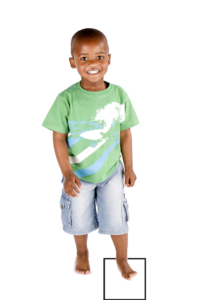
Finger Paint
Provide one or two colors of finger paint. Place a paper on an easy-to-clean surface. Have your child dip a finger in the paint and draw on the paper. Try new ways to apply paint: use more than one finger, use side of hand to smear paint, tap one finger to create dots. Ask: How does the paint feel? Is it cool? smooth?

Walking Feet
Say: Today we will learn how to use Walking Feet. When we walk, we are in better control of our body. Running is for outdoors. Pretend to run across the room and bump into a chair. Ask: Is that a safe or unsafe way to move indoors? Then walk safely around the chair. Ask: Is that safe or unsafe? Have your child practice walking safely.
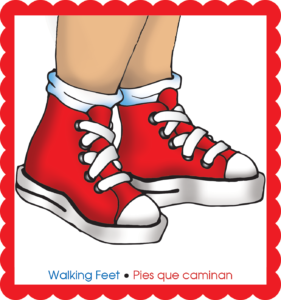
Daily Message
Point to your nose.
- Say the sentence. Have your child repeat and then point to the body part named.
- Ask your child to recall the first word in the sentence. Write the word. Point to the word and have your child “read” the word with you.
- Repeat for each word. Track left to right (move your finger under the words) as you “read” the sentence together.
Writing Together
Listen to the chant “I Can, Can You?” Have your child echo the final “Can you?” in each verse and perform the action. Write: I can __________ my __________ . Have your child suggest ways to finish the sentence. Write down the suggestions. Read the sentences as you track the words with your hand. Click image for lyrics.
Storytime
Gather several small textured objects (sandpaper, sponge, dry bar of soap, ball). Have your child rub each object and describe the texture. Explain that our skin has touch receptors that send messages to our brain. Say: When we read Your Fabulous Skin today, listen and look for the page that talks about how our skin helps us feel.
The 20-Second Rule
Review the steps for washing hands from yesterday. Explain that it is important to wash hands long enough to get rid of all germs. Help your child understand how long this is by having her count with you from 1 to 20 while washing.

Fingers as Tools
Have your child think of ways to cut paper if there were no scissors. Explain that people can use their bodies to do certain tasks. Say: Parts of your body can be tools. What body parts could you use to “cut” paper? Have your child practice using finger and hand muscles to tear a paper into strips.

Getting Dressed
Give directions to your child using words that describe where to put a body part or piece of clothing while dressing. Say: Slip your arms through the sleeves of your shirt and your feet inside your shoes. Put the hat on top of your head and the belt around your hips. When it’s time to go outside, have your child direct you as you put on your coat and hat.

My Shadow
Go outside in the sun and point out your child’s shadow or have your child stand in front of a light in a darkened room. Point to parts of the shadow and ask your child to identify matching body parts. Take a turn and have your child point to body parts on your shadow.

Greeting Others
There are many ways to greet a visitor: high-five, fist bump, hug, wave, nod, elbow bump. Some greetings require closeness and touch. Others can be done from a distance. Talk with your child about greetings that are appropriate for you and your family. Practice these greetings with your child and decide on your favorites.

Daily Message
Stomp your feet.
- Say the sentence.
- Write the sentence as your child recalls each word.
- Write your child’s name. Ask your child to find a letter in her name that is also in the sentence. If your child’s name does not match letters in the sentence, use a family member’s name.

Hop, Jump, Leap
Find a large open area where your child can move freely. Invite your child to watch Charity Kahn’s movements for “Hop, Jump, Leap, Bounce, Pounce” and then join in moving like the different animals in the song.
A Picture of Me
Look at the journals that you and your child created last week. Ask: Which one is yours? How did you know? Show how to open the journal to the first page. Have your child use crayons or markers to draw a picture of herself and write her name. Provide a name card if needed and assist if asked. Don’t forget to draw your own self-portrait in your journal.

Storytime
Watch Your Fabulous Skin with your child. After watching, talk with your child about skin. Focus on the idea that skin is stretchy. Say: Look at your knuckles as you hold your fingers straight and then bend them. Ask: How does your skin change? Why is it important that the skin stretch?
Brushing Teeth
Talk about the steps in brushing teeth: What do we do first? next? last? Show how to brush with small, circular strokes. Remind your child to brush all areas (move from front to back, get behind teeth). Have your child practice with her own toothbrush and toothpaste. Make brushing teeth a daily routine.

Near and Far
Face your child. Hold hands. When you are standing near someone, you can reach out and touch that person. Have your child hold one end of a 6-foot length of yarn. Hold the other end and move away until the yarn is stretched tight. The yarn shows how far apart you are. Have your child stand near a chair and then far away from the chair.

Be the Mirror
Play “Be the Mirror.” Have your child copy your actions or the actions of a sibling. Two players face each other. One strikes a pose. The other player copies the pose. Players should take turns being the leader. Extend the activity by having your child describe the pose. (For example: I put one hand on my head and one hand on my knee.)

Ready to Listen
Develop a signal to let your child know it’s time to listen. For example, you might say: Give me five! as you raise a hand in the air. Your child will imitate you as you lift each finger to count and name a body part:
one—eyes looking
two—ears listening
three—mouth closed
four—hands still
five—feet quiet.
Great! You are ready to listen!
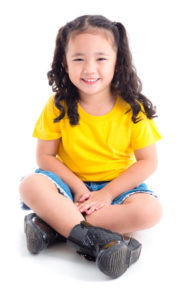
Daily Message
Clap your hands.
- Say the sentence.
- Write the sentence as your child recalls each word.
- Write your child’s name. Ask your child to find a letter in her name that is also in the sentence. If your child’s name does not match letters in the sentence, use a family member’s name.

Tony Chestnut
This silly song is about a man named “Tony Chestnut.” The song is filled with words that have more than one meaning. Don Monopoli created movements using those words. For example, when he sings the name Tony, he touches his toe and his knee. Watch the video, sing along, and get some exercise.
Storytime
Read Your Fabulous Skin. Remind your child about the different colors and textures of skin. Click images to look closely at the skin of the animals. If you have a magnifying glass, use it to examine the animals’ skin.
Style Your Hair
Ask your child to stand in front of a mirror. Have her use a comb and brush to experiment with styling in different ways (parting hair down middle, on the left or right). Describe the direction of the brush strokes (forward, backward, to the left or right). Ask: What is your favorite look?

Technology & Tools
Technology is about carrying out ideas that make life easier. Have your child look at a collection of school supplies. Ask: Which tools help you draw? If your child points to a marker, ask: How was the marker designed to make drawing easier? (ink, pointed tip) Ask: Which tool helps you draw a straight line? Hold the ruler still as your child makes a mark along its edge.

Coin Toss
Place a plastic or paper plate on the floor. Invite your child to stand nearby and toss five coins one at a time. Have your child describe where each coin lands (near, far, inside, outside) the plate. Ask: How many coins landed on (off) the plate? Which coin is the closest (farthest) from the plate?

Walk the Line
Stretch a rope or 8-foot length of masking tape on the floor or patio. Ask your child to walk the line while balancing a beanbag or small stuffed animal on her head. Place the beanbag in different positions (on a shoulder, on an outstretched hand) and repeat. Ask: Was it more difficult to walk the line with the beanbag on your head or your shoulder? Why?

My School and Me
Week 3: My Senses
We have five senses. We can see, touch, hear, taste, and smell. Our senses help us gather information to learn about our world. We use a different body part for each sense. We use our eyes to see, our fingers to touch, our ears to hear, our tongue to taste, and our nose to smell.
Word of the Week: senses
Before You Begin
Watch these videos to better understand the concepts your child will be learning this week. These are not videos you will watch with your child. These are just for you!

Books to Read
- Frog Street Poems and Rhymes eBook
- My Backyard and My Senses eBook
- Sensational Senses eBook
- Sensational Senses Read-Aloud video
Supplies to Gather
- bag
- bottle cap
- can
- dark chocolate
- flashlight
- household items with a scent (coffee, soap, cologne)
- journal
- lemon
- markers and crayons
- mirror
- paper
- pencils
- piece of candy
- plastic spoon and fork
- ruler
- salt cracker
- shoes
- socks
- tricycle or toy truck
Daily Message
My eyes see.
- Say the sentence. Have your child repeat and then point to the body part named.
- Say the sentence again and tap for each word. Ask: How many words did we tap?
- Write the sentence as your child recalls each word. Count the words as you point to and read each word.
Storytime
Watch the read-aloud video Sensational Senses with your child. Explain that Mr. Gonzales will read facts about our five senses. When the video is over, ask: Why do you think the author of book says that our senses are sensational?
Crayon Colors
Remove a red, blue and yellow crayon (or marker) from your child’s box of school supplies. Ask your child to tell the color of each crayon. Explain that color is an attribute (characteristic) that tells about the crayons. Ask: What other objects can you find that are the same color (have the same attributes) as the crayons?

Stop, Look, Listen
Review safety rules for crossing a street with your child. Go outside and practice at a real intersection or mark off a pretend intersection in your house or yard. Model how to stop and look both ways before crossing carefully. Teach your child to say: Stop, look, and listen before you cross the street.

Helping Hands
Remind your child that you have been practicing Listening Ears and Walking Feet. Say: Today we will learn how to use Helping Hands. Using helping hands means we are helpful to others. Ask: How might you use helping hands if I drop my pen? What if milk spills on the counter? Talk about other possible ways to use helping hands.

Daily Message
My ears hear.
- Say the sentence. Have your child repeat and then point to the body part named.
- Say the sentence again and tap for each word. Ask: How many words did we tap?
- Write the sentence as your child recalls each word. Count the words as you point to and read each word.
Sound Pattern
Create a sound pattern by tapping two pencils. For example, tap two pencils together two times, pause, tap the pencils together two times, stop. Then have your child copy the sound pattern. Continue with more patterns. Point out to your child that our ears allow us to hear the pattern and our brains help us remember the pattern.

Storytime
Explain that the story My Backyard and My Senses is about a little girl who uses all of her senses. Help your child name the five senses (see, hear, touch, taste, smell). Read the story. Pause when the girl in the story tells about a sense and have your child name the body part used. Ask: How do you use your senses in our backyard?
Smell It!
Before doing this experiment, find several items in your house that have a smell that your child would recognize (Dad’s cologne, liquid soap, orange slice, coffee). Have your child close his eyes and use his sense of smell to identify each item. Say: Our nose helps us identify familiar items because we recognize their smell.

Electric Power
Invite your child to help you search around the house for tools that use electricity. Explain that some technology must be powered on or plugged into an outlet to work. Count the number of electric tools you find. Make a pencil mark (tally) on a paper for each tool. Remind your child to always ask an adult to power on or plug in an appliance.

Texture Hunt
Walk around inside or outdoors. Notice different textures. Some things will be smooth and others rough. You might even find a prickly or bumpy surface. Use both your eyes (to see), your hands and your feet (to touch). Talk about the different textures. For example, you might say: The kitchen counter feels smooth.

Daily Message
My nose smells.
- Say the sentence.
- Write the sentence as your child recalls each word.
- Write the letter s below the sentence and tell your child the letter’s name.
- Ask your child to find the letter s in the sentence. Ask: Is there more than one letter s?

Writing Together
Invite your child to smell different foods in your kitchen. Talk about the smells and ask: What do you like to smell? Write: I like to smell __________ . Complete the sentence with your child’s idea. Write another sentence with an idea of your own. Read the sentences.

Storytime
Show page 6, “My Senses Bring Me Gifts,” in Frog Street Poems and Rhymes. Explain that this is a different kind of story. It is called a poem. This poem is about things in nature we can enjoy because we use our senses. Read the poem to your child. Ask: What things do you notice outdoors using one of your senses?
Your Tongue Tastes
Conduct this experiment with your child:
- Have your child close his eyes and lick a salty cracker.
- Ask: What did you lick? How did it taste?
- Repeat with a piece of candy, a slice of lemon, and a bit of dark chocolate (or chocolate chip).
Click image to show a large diagram of the tongue.
Sorting Socks
Show your child a matching pair of socks. Explain that they are identical. They look exactly alike. We call the two socks a pair. Invite your child to match pairs of socks you have washed and removed from the dryer. Check each pair your child matches. Ask: How did you know these socks go together? Be sure to thank your child for using helping hands.

Numerals in My House
Show your child a ruler. Ask: What numerals do you see? What do you think the numerals are for? How might they be used? Explain that some tools (technology) like rulers use numerals for counting and measuring. Have your child look around your house to find electrical appliances or other tools with numerals.

Outdoor Walk
Take a walk outdoors with your child. Point out things you see, hear, and smell. Invite your child to touch safe things and then describe the feel of each item. Take a few photos with your cell phone. When you get home, have your child tell how he used his senses in each photo.

Daily Message
My tongue tastes.
- Say the sentence.
- Write the sentence as your child recalls each word.
- Write your child’s name. Ask your child to find letters in her name that are also in the sentence. If your child’s name does not match letters in the sentence, use a family member’s name.
- Talk about the letter shapes: Which letters have straight or curved lines?
My Journal
Reread the sentences that you wrote yesterday with your child. Have your child open her journal to the first blank page. Have her draw pictures of things that she likes to smell. Help your child label the pictures.

Are You Listening?
Use songs between activities to signal a change or to call your child back to your work area. “Are You Listening?” is a good example of the kind of song your child will hear at school. Change the words as needed. For example, you might sing: Are you listening, (repeat), (child’s name)? (repeat). Come and sit with me. (repeat) Let’s begin. (repeat)
Storytime
Watch the read-aloud video Sensational Senses with your child. Ask: What did you learn when you watched the story this time? Focus on the chant that Mr. Gonzales did at the end of the video. Return to the time stamp 5:25 on the video. Have your child echo the chant and do the motions with Mr. Gonzales.
Matching Shoes
Place a collection of shoes in a mixed-up pile on the floor. Invite your child to pair each shoe with its mate. Ask: How did you decide that these two shoes are a pair? Ask your child to describe how each pair is like other pairs and how they are different.

Round or Square?
Have your child look closely at a bike, tricycle, or toy truck. Ask: Why are the wheels round? How do they help the toy move? Have your child roll a can. Does it roll smoothly? How is it like a wheel? Try rolling a box. Does it roll smoothly? Why is a circle a good shape for a wheel?

Feel It, Name It
Secretly place a plastic spoon inside a paper or cloth bag. Have your child reach inside without looking to feel the spoon. Ask: What can you tell me about the object? Your child may simply name the spoon. Encourage descriptions as well (smooth, long end, scoop). Repeat with a fork, a plastic cup, and a bottle cap. Say: You are using your sense of touch to identify the objects.

What’s for Dinner?
Help your child notice smells and tastes. As you start making dinner, say: Use your nose to guess what we are having for dinner. After guessing (predicting), have your child take a small taste without looking. Ask: Was your nose’s guess correct?

Daily Message
My hands feel.
- Say the sentence.
- Write the sentence as your child recalls each word.
- Point to the word feel. Say: Let’s look at the letters in this word. Which letters are curved? (e, f) Which letters are straight? (l).
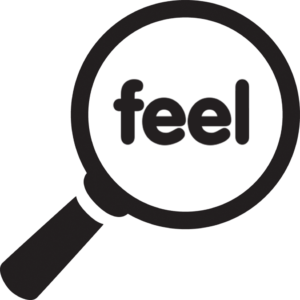
Thumb in the Air
Remind your child about the song “Put Your Thumb in the Air” that you sang last week. Sing the song again. Try to maintain balance as you sing verses and add new moving body parts. Remember to hold the position of the ones you’ve already sung about. Ask: Which movement do you like best? least? Click image for lyrics.
Storytime
Read Sensational Senses. Talk about ways our senses keep us safe. For example, our senses help us know when something is too hot to touch and let us know that we need to put on a jacket to keep our body warm. Ask: How does your nose help keep you safe? How do your ears help keep you safe?
What’s That Sound?
Hide your hands behind your back. Snap your fingers. Ask: What am I doing? How can you tell without seeing? Confirm that you made a snapping sound with your fingers. Say: Your ears hear sounds. Have your child listen carefully without looking to identify other sounds you make (rattling keys, removing flip top from can of soda, opening door).

Do, Re, Me
Start low and move higher as you sing each syllable: do, re, mi, fa, so, la, ti, do. Invite your child to echo. Introduce low and high to describe the pitch of the first and last syllables. Sing the syllables two more times. First, sing the scale softly and then sing it loudly. Ask: What sense would you use to match my song?

Funny Faces
Sit in front of a mirror or take a selfie with your child. Take turns making funny faces. Discuss the body parts used to make each face. For example, you might say: You showed all of your teeth. I used my tongue to make my funny face. You made your eyes get really big.

My School and Me
Week 4: My Feelings
We all have emotions (feelings). We can feel happy, sad, frightened, disappointed, frustrated, angry, and surprised. This week, your child will learn how to identify emotions and discover ways to handle his or her feelings.
Word of the Week: emotions
Before You Begin
Watch these videos to better understand the concepts your child will be learning this week. These are not videos you will watch with your child. These are just for you!

Books to Read
- Feelings Are Real eBook
- Feelings Are Real Read-Aloud video
- Lucy and Copito eBook
Supplies to Gather
- button
- can
- comb
- cups (different sizes)
- journal
- lid
- markers and crayons
- paper towel
- pencil
- penny
- plastic water bottle
- plate
- pot of boiling water
- ruler
- sponge
- spoon
- straws and sticks
- string
- tissue
If You’re Happy
Teach your child the action song “If You’re Happy and You Know It.” After you are comfortable with the words and actions, try something new. Create verses using different emotions and actions that reflect them. For example, you might sing: If you’re excited and you know it, jump up high. Click image for lyrics.
Daily Message
I feel happy.
- Say the sentence. Have your child repeat the sentence.
- Ask your child to talk about a time he felt happy.
- Say the sentence again holding up one finger for each word. Ask: How many fingers did we hold up?
- Write the sentence. Count the words.
Storytime
Watch the read-aloud video Feelings Are Real with your child. Mrs. Ebel will read the book about different feelings or emotions we have. Encourage your child to respond to Mrs. Ebel’s questions as the two of you listen and watch.
Straws and Sticks
Before doing this activity, collect a handful of straws and have your child collect different-sized sticks on an outdoor walk. Ask: How are they alike and different? Encourage your child to describe the color, shape, and size. Spread the straws and sticks out and encourage your child to play with them (put them in groups, build something, lay them end to end).

An Engineer
Say: Engineers are the people who see a problem and try to solve it. They use math, science, technology, and art. Have your child look at a hinged door in your house. Open and close the door. Explain that an engineer designed the hinges to move so the door could open and close. Ask: Would you like to be an engineer? Why or why not?

Look at Steam
From a safe distance, have your child watch a pot of boiling water. Draw attention to the rising steam. Say: The water changes to steam when it is hot. Hold a lid a few inches above the pot so that it blocks the steam. Watch as droplets of water appear on the lid. Say: Steam changes back to water when it cools. Ask: How is steam different than ice?

How Are You Today?
Use markers to create a chart with simple face illustrations. Label the emotions. Pause during learning times this week and point to the chart. Ask your child: How do you feel? Add additional labeled faces as needed.

Expressing Emotions
Explain to your child that everyone has emotions. Emotions help express feelings. Say: Feeling happy, frightened, sad, surprised, and angry is normal. Everyone has emotions. Play “Happy or Sad.” Name something that might cause your child to be happy or sad, such as: We are going outside to play. or It’s raining. Your child will either smile or frown to show the feeling happy or sad.

Daily Message
I feel sad.
- Say the sentence holding up one finger for each word. Ask: How many fingers did we hold up?
- Write the sentence. Point to the lowercase l in the word feel. Trace the letter with your finger as you say: start high and pull down.
- Have your child say the letter name and draw the letter in the air as you repeat the directions.
Happy Dance
Watch the music video of “Happy Dance.” Join Don Monopoli and his friends as you dance along with this upbeat song. Ask: What songs do you know that would spread happy all around? What are some other ways you might spread happy?
Storytime
Ask your child to predict what Lucy and Copito might be about by looking at the cover. Explain: Lucy, the girl in the story, has many feelings while playing with her puppy. Read the story. Pause when the story describes an emotion. Ask: What made Lucy feel (emotion)? After the story, have your child share personal experiences about feeling emotions.
New Ideas
Show your child a comb. Ask: How could you make a sound with a comb? Accept all your child’s suggestions. Say: There are many different ways to make sounds with a comb (tap on table, rub comb’s teeth with finger, tap combs together). Say: Thinking of lots of ideas is called brainstorming. Brainstorm ways to make sound with an empty plastic bottle.

Let Off Steam
Repeat the steam experiment from yesterday. This time place a lid on the pot until you hear water boiling. Have your child stand at a safe distance. Remove the lid to allow the steam to escape. Say: Anger feels like boiling water deep inside our bodies. This anger can build up like steam. Sometimes we need to “let off steam.” Practice a calming strategy to release stress (steam).

Water Play
Explain that people often feel that playing in water is calming. Have your child play in a tub of warm water with cups of different sizes. (This activity could be done during bath time.) Ask: How do you feel when you are playing in the water? Do you think that warm water is more soothing than cold water?

Big Voice
Remind your child that the two of you have agreed to help keep your home safe using Listening Ears, Walking Feet, and Helping Hands. Today you will introduce another helpful behavior: Using a Big Voice. Say: Using a Big Voice means we use our words to help others learn a safer way to treat us. Click the image to see some examples of what this sounds like.
Daily Message
I feel loved.
- Say the sentence.
- Write the sentence as your child recalls each word.
- Trace the letter o with your finger as you tell your child the letter name.
- Have your child use a finger to circle the letter o and say its name. Repeat the steps with the lowercase l.

Writing Together
Ask your child to name an emotion, such as frustrated, sad, or happy. Use the emotion your child chose and write: I feel frustrated when __________ . Complete the sentence with your child’s idea. Write another sentence using another emotion. Read the sentences.

In Control
The song, “I’m in Control,” is about managing your emotions. Explain: Learning to control the way you act when you are upset, angry, or frustrated is important. When you can manage your emotions, we say you are in control. Enjoy listening to the words and marching with the music. Say: Tell about a time when you were in control. Click image for lyrics.
Storytime
Read Feelings Are Real. Select one emotion to talk about with your child. For example, talk about how Brooklyn finds a lost dog and wants to keep him. Ask: How would you feel if something like this happened to you? What would you do to keep your emotions in control?
Pen for a Pup
Gather some pretzel sticks or straws and a penny. Explain to your child that you will pretend the penny is a pup. Challenge your child to build a pen using the sticks (straws) so the pup will be safe and not escape. When the pen is built, point out the sides and corners (where the lines meet). Ask: What other shape pens can you build?
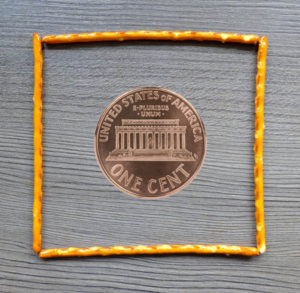
Noisemaker
Show your child an empty plastic bottle and ask: How would you turn this bottle into a noisemaker? Think about the ideas you thought of on Day 2 (tap the bottle, put something inside and shake it, blow air across the top). Say: Your job today is to design and build a noisemaker. Help your child find more materials for the project (pebbles, paperclips).
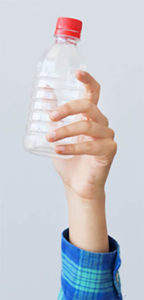
Straight or Curved
Collect some small household objects (ruler, spoon, bottle cap, craft stick, button). Have your child sort the objects by straight and curved edges. Have your child choose several objects and trace the edges. Ask: What kind of line did you make?
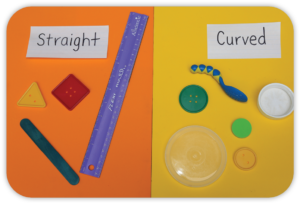
Open and Closed
Use a piece of string or ribbon to make a shape. If the ends of the string touch, the shape is called a closed shape. If the ends of the string do not touch, it is an open shape. Ask your child to tell you if the shape you make is open or closed. Practice making lots of open and closed shapes with your child. Have your child make some shapes for you.
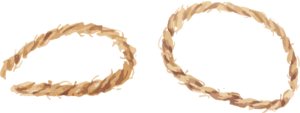
We Wish You Well
Teach your child to show empathy and caring for others. Support family members who are having a difficult day or send positive thoughts to someone far away. Ask: What wish would you make for Gram? (or Uncle Paulo or Cousin Grace?) Put your hands over your hearts and repeat the chant together.
We wish you well
We wish you well.
All through the day
We wish you well.
Daily Message
I feel frightened.
- Say the sentence.
- Write the sentence as your child recalls each word.
- Trace the letter t with your finger as you say: pull down, slide across. Tell your child the letter name.
- Have your child use a finger to trace the letter t and say its name. Repeat the steps with the lowercase l.
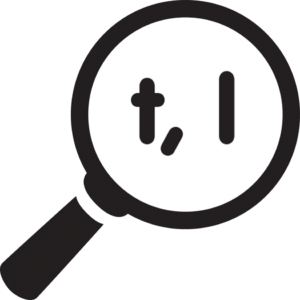
My Journal
Help your child open the journal cover to the first page and turn to the next blank page. Have your child use writing tools to illustrate a feeling. Help label the drawing using your child’s own words.
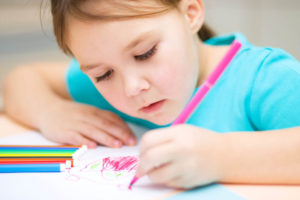
If You’re Surprised
Listen to “If You’re Surprised and You Know It.” There are many ways to express a feeling or emotion. Say: Sometimes you shout or laugh or stomp to show how you feel. But you can also use words. After you sing the song, ask: What would make you feel surprised? Click image for lyrics.
Storytime
Watch the read-aloud video Feelings Are Real with your child. Say the sentence that repeats in the story each time Mrs. Ebel reads it. (I’m learning to deal with the way I feel.) After the story, have your child give examples of how he or she deals with feelings.
Absorbing Water
Show your child a tissue and talk about ways it might be used. A tissue can absorb (soak up) the water. Sprinkle a drop of water on a plate. Give your child a tissue to absorb the water. Have your child experiment using other materials (paper towel, sponge, plastic spoon) to see what will and will not absorb water. Discuss experiment results.
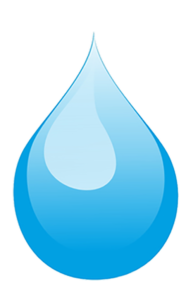
Trace the Outline
Have your child use a marker to trace around your hand, a small box, and a can. Explain: When we trace an object, we draw an outline of the object. The outline shows the shape of the object. Ask: Is the edge of the box straight or curved? How do you know? Encourage your child to trace other objects and describe the shapes of outlines.
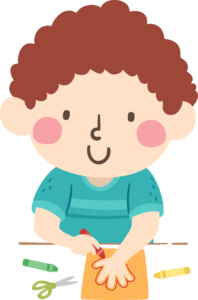
Move Your Feet
Name a way to move your feet. Move your feet in that way. Ask your child to copy your actions. Ask your child to name and show a move. Take turns seeing how many different ways you can move your feet. Ask: How do you move your feet when you are frightened? angry? surprised? happy?
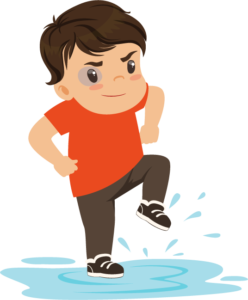
Helpful at Home
Everyone in the family needs to help. Ask: What could you do to be helpful in our house? Suggest that your child make a commitment today to do a specific job that would be helpful. (I will pick up my markers when I finish drawing.) Be sure to notice when your child is helpful and comment: You __________ . That was helpful.
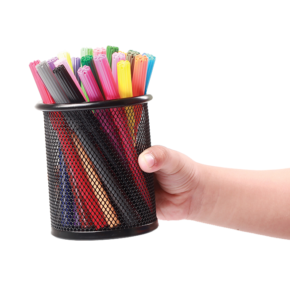
Daily Message
I feel frustrated.
- Say the sentence.
- Write the sentence as your child recalls each word.
- Write the letters t and l on the paper.
- Have your child use a finger to trace the letters and say their name.
- Have your child find the letter t and l in the sentence.

Letter Shapes
Your child’s ability to tell the difference between letter shapes will help your child later learn letter names and sounds. Challenge your child to make an o with his mouth and body. Confirm that an o is like a circle. Then look for an o in print. Click image to show the word emotions.
Storytime
Reread Lucy and Copito with your child. Ask: How was Lucy feeling when she couldn’t find Copito? (worried) Explain that sometimes we worry because we care about things. Ask: What did Lucy do when she was worried? What would you do if you were worried? Help your child think of ways to deal with worry (talk to someone, ask for help, ask for a hug, draw a picture).
Measure and Mix
Some scientists are called chemists. Chemists mix materials together to create new materials. They measure materials carefully. Have your child help you measure the following ingredients into a bowl: 3 cups water, 1 cup liquid soap, ½ cup cornstarch. Mix the ingredients well. Pour into a jar with a lid to store. Ask: What do you think we made?
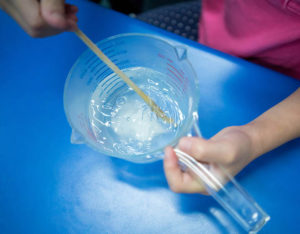
Bubble Shapes
Pour a little of the mystery liquid that you created in the Measure and Mix activity into a shallow bowl. Give your child these directions:
- Dip one end of an empty cardboard tube into the liquid.
- Put your mouth over the other end of the tube and blow.
- If necessary, show how to blow steadily so a bubble forms.
Ask: What will we call our mixture?
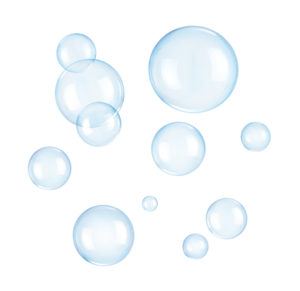
Mood Music
Have your child listen to several songs representing a variety of music styles (from a playlist or the radio). Ask: How do these songs make you feel? sad? happy? excited? Let your child choose a favorite song and either draw with markers or perform a dance that shows the mood of the music.






